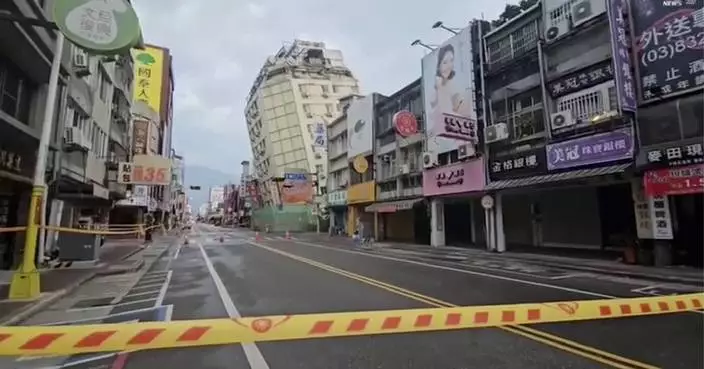Nearly two-thirds of the buildings that collapsed in Mexico City's monstrous earthquake last month were built using a construction method that is now forbidden in seismic hotspots in the United States, Chile and New Zealand, according to new data compiled by a team of structural engineers at Stanford University.
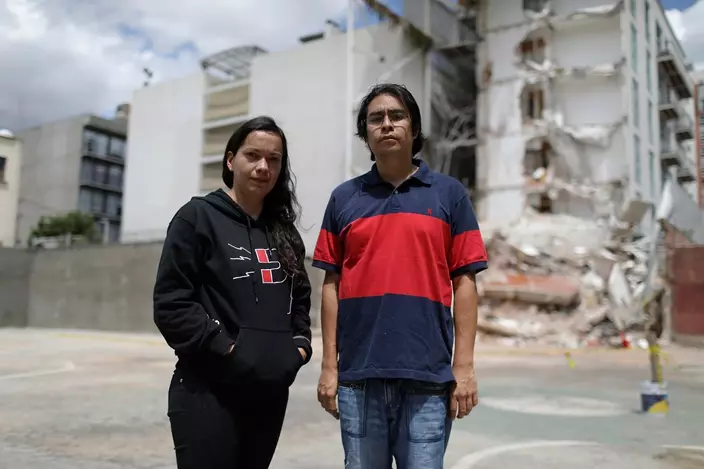
In this Sept. 24, 2017 photo, Miriam Anahi Abadia, left, and her husband Led Esau Ramirez, pose for a photo in front of their earthquake -damaged apartment building on Emiliano Zapata Avenue in Mexico City. (AP Photo/Miguel Tovar)
The suspect building technique called flat slab — in which floors are supported only by concrete columns — caused 61 percent of the building collapses in last month's magnitude 7.1 quake, which killed 369 people and blanketed tree-lined avenues in rubble.
Now, several prominent engineers say some of those structure failures could have been prevented and lives could have been saved had Mexico City officials only gone forward with a proposal to forbid that type of construction when they toughened building codes after the 1985 earthquake in Mexico's capital.
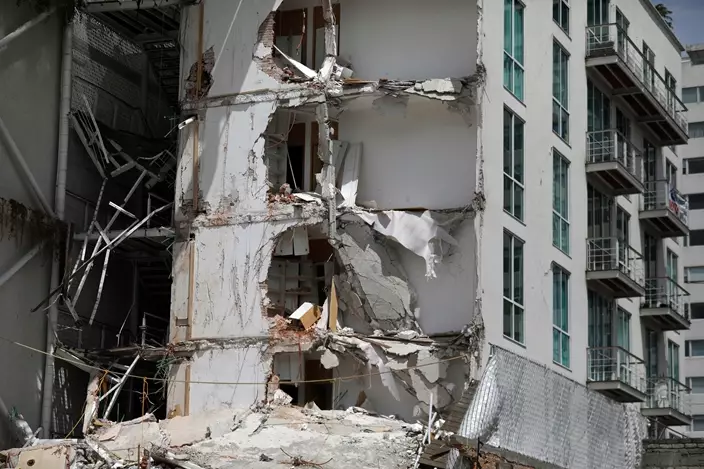
This Sept. 24, 2017 photo shows an apartment building that was partially destroyed during the 7.1 magnitude earthquake, on Emiliano Zapata Avenue in Mexico City. (AP Photo/Miguel Tovar)
"We have known for 30 years that this system killed lots of people, so why are we still using it?" asked Eduardo Miranda, a professor of civil and environmental engineering at Stanford and global expert on earthquake-resistant design who compiled the data obtained by The Associated Press. "The right decision after '85 would have been to completely ban this kind of construction. We could have saved lives."
Anahi Abadia and her husband were among the fortunate: they were in Home Depot when the earthquake hit, shaking the store so fiercely the structure screeched. Minutes later, a text came in from their neighbor: The elegant apartment they had purchased only six months earlier had collapsed, rendering their new home a pile of crushed concrete.
Two women working in Abadia's trendy apartment building died on Sept. 19 when the structure collapsed after a corner column failed, and the flat-slab structure pancaked, Miranda said.
The concrete slabs used to build floors and ceilings can be cast to include some rebar for reinforcement, and give builders greater flexibility in room layout and allow for higher ceilings.
But in an earthquake, without reinforced concrete walls or lateral bracing to resist forces pushing structures sideways, buildings with that design can move too much. The columns, and connections between the slabs and columns, can easily break, prompting collapse, as was the case at a school where 26 people died, most of them children.
But at Abadia's building, the construction method was only the start of the problems: The units were designed by an architect whose license lapsed, and approved in a borough where auditors previously found illegal construction occurred unchecked.
Experts concur that the devastation caused by last month's earthquake in the city of 8.9 million people could have been much worse had the building codes not been so strong, but it also has forced an uncomfortable conversation about their shortcomings. Now, as experts race to toughen standards to retrofit hundreds of damaged buildings, they are grappling with the reality that corruption has allowed hundreds of structures to be built outside the rules atop the soft soils of Mexico City's ancient lakebed.
In the crisis following the 1985 quake, a group of academics, building officials and engineers drafted emergency recommendations to strengthen Mexico City's seismic codes, which were swiftly passed into law.
Some architects and builders were opposed to an outright ban on flat slab construction, said Miranda, who wrote reports that informed the committee.
"There were lots of builders and owners who were not going to be happy that you just stopped their construction," said Miranda, who later served on Mexico's code committee in the 1990s, and on committees funded by the U.S. Federal Emergency Management Agency. "These things start as technical conversations but then you run into policy and politics."
The new codes allowed flat slab construction if developers designed the building to be seismically stronger than structures with beams or concrete walls.
Authorities did pay enough attention to evaluating if existing flat slab structures needed a seismic retrofit, Miranda said.
"It would have been better to have insisted very much about not using flat slab," said Roberto Meli, a renowned structural engineer who served on the code committee in 1985, and went on to head the federal Center for Disaster Protection founded after that quake.
The new codes gave more responsibility to a network of private engineers who are hired and paid by developers, and who submit structural plans to borough authorities. In practice, that means private engineers — not government experts — vet projects' structural safety, and corruption can intervene.
"Corruption can come in many forms, from the moment someone accepts a bribe to when someone falsifies documents, or fails to present the right structural plans to borough authorities," said Renato Berron, head of the Institute for the Security of Constructions of Mexico City, a city agency.
In recent decades, middle-class enclaves close to the city's center have experienced vertiginous growth, and many unpermitted helipads and illegal, multi-floor garages have sprouted up between historic homes. In the last 15 years, residents of Abadia's Benito Juarez borough and two others nearby have sent in the highest number of complaints about land-use violations to a city watchdog agency.
Now, those same boroughs are home to dozens of damaged buildings, according to data from the Mexican Society of Structural Engineering. Miranda, whose team compiled the data on the 44 collapses through in-person visits and detailed structural analysis, estimates that hundreds of damaged buildings were built with flat slab systems, including some built relatively recently.
Meli said he and the committee will seek to strengthen retrofitting standards first, and by early next year may reexamine flat slab, although he is not convinced prohibiting the method outright would have worked.
Abadia said she hopes shoddy builders will be held responsible.
"A new building should not fall down," she said.
VILLA MADERO, Mexico (AP) — As a drought in Mexico drags on, angry subsistence farmers have begun taking direct action on thirsty avocado orchards and berry fields of commercial farms that are drying up streams in the mountains west of Mexico City.
Rivers and even whole lakes are disappearing in the once green and lush state of Michoacan, as the drought combines with a surge in the use of water for the country’s lucrative export crops, led by avocados.
In recent days, subsistence farmers and activists from the Michoacan town of Villa Madero organized teams to go into the mountains and rip out illegal water pumps and breach unlicensed irrigation holding ponds.
A potential conflict looms with avocado growers — who are often sponsored by, or pay protection money to, drug cartels.
Last week, dozens of residents, farmworkers and small-scale farmers from Villa Madero hiked up into the hills to tear out irrigation equipment using mountain springs to water avocado orchards carved out of the pine-covered hills.
The week before, another group went up with picks and shovels and breached the walls of an illegal containment pond that sucked up water from a spring that had supplied local residents for hundreds of years.
“In the last 10 years, the streams, the springs, the rivers have been drying up and the water has been captured, mainly to be used for avocados and berries,” said local activist Julio Santoyo, one of the organizers of the effort. “There are hamlets in the lower part of the township that no longer have water.”
Santoyo estimated that about 850 of the plastic-lined, earthen containment ponds have sprung up in the hills around Villa Madero, usually soon after planters have illegally logged or burned the native pine forest. Pines help the soil retain water, while avocado trees deplete it.
Francisco Gómez Cortés said residents of his hamlet, El Sauz, had been asking the landowner for 15 years to allow the spring to flow downhill to their community.
After a year in which Mexico received only about half its normal rainfall, residents became desperate, and last week they worked up the courage to hike up the hill and rip out pumps and hoses for the avocado orchard.
“We don't have enough water for human consumption,” Gómez Cortés said.
“It’s sad. It’s sad to walk down these trails that are now dry, when they once had trees and springs,” he said. “They haven’t even left any water for the (forest) animals that nest along the banks.”
In a sign of how seriously the local government is taking the potential threat, the group was accompanied by the mayor of Villa Madero, who blamed outsiders for the problem.
“There are people who aren't from this town, who come to our township and are invading us,” Mayor Froylan Alcauter Ibarra said. “They are taking water away from the people who live downhill, and they don't realize these are the poorest people.”
Residents say they don't want to deny water entirely to the orchards and have proposed an agreement to give landowners 20% of the water from local streams, if they allow the remaining 80% to keep flowing. They say they haven't gotten any response yet.
Drug cartels often make money from illegal logging and extorting money from avocado growers in Michoacan. The activists around Villa Madero have suffered threats, kidnappings and beatings in the past.
“We are running a serious risk of them killing us for protesting,” Gómez Cortés said. “Out of necessity, we are doing what the government should be doing.”
The government has long done little to limit the growers and combat deforestation and water takeovers. But it does seem to have developed a sudden interest in preventing the looming conflict.
In March, activists organized a meeting nearby at Patzcuaro Lake to demand authorities do something about the fast-declining water levels. Patzcuaro is a shallow but extensive lake in Michoacan with a beautiful colonial town on its shores and an island of fishermen perched in the middle.
The fishermen of Janitzio island with their shallow boats and hooped, figure-eight nets were made famous by photographers and filmmakers in the 1940s and 50s as a symbol of Mexico's folk traditions. The town of Patzcuaro draws hundreds of thousands of tourists.
But due to the drought, deforestation, sediment buildup and the increased water demands from avocado and berry growers, Patzcuaro lake has been reduced to about half its size. You can now reach the Janitzio island by wading, and activist Juan Manuel Valenzuela estimates that 90% of the boats that used to fish and ferry tourists around are now out of service.
Nearby Lake Cuitzeo, one of the largest freshwater lakes in Mexico, is now nearly dried up.
“We cannot allow them to extinguish our lakes,” Valenzuela said. “It would be a tragedy for Michoacan.”
Alejandro Méndez, Michoacan's state environment secretary, acknowledges that the problem has gotten out of hand. So scarce has water become in the once-lushly forested lake areas that orchard owners often send tanker trucks to suck thousands of gallons from the lake to water their groves.
“As many as 100 trucks could be seen taking water from the lake,” Méndez said of the situation in March.
So about a week ago, the state police began patrolling the lake shore and detaining any truck drivers they saw extracting water. And Méndez said the state has begun monitoring agricultural holding ponds to see if any are getting refilled from the lake.
While Lake Patzcuaro has grown and shrunk in the past, this time it may be terminal; farmers are starting to pasture livestock and plant crops on the lake bed.
“It will be difficult, because the humans and the livestock will survive, barely, but the animals and the plants will be gone — that will all be dried up and gone,” Gómez Cortés said.
AP writer Mark Stevenson in Mexico City contributed to this report.
Follow AP’s coverage of Latin America and the Caribbean at https://apnews.com/hub/latin-america
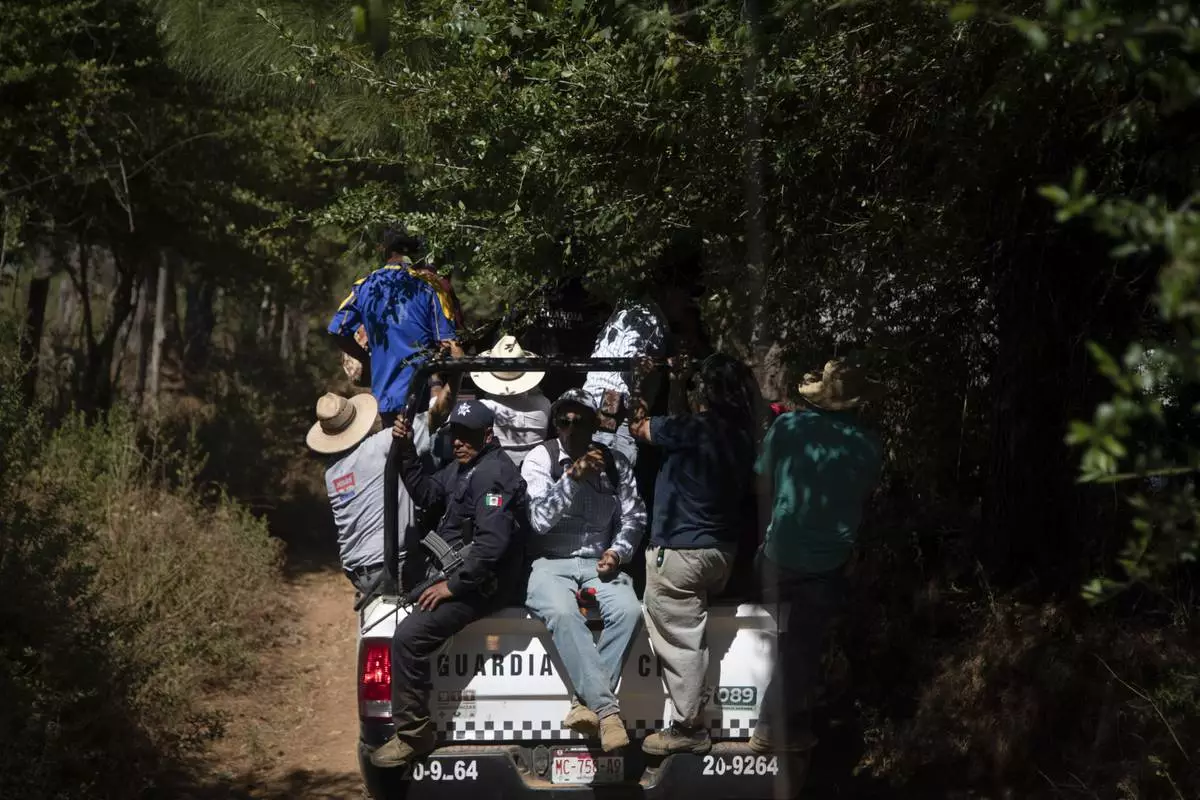
Locals ride in a National Guard truck in search of unlicensed water intakes and irrigation holding ponds that irrigate avocado and berry orchards during a drought in the mountains of Villa Madero, Mexico, Wednesday, April 17, 2024. Subsistence farmers and activists from the Michoacan town of Villa Madero organized teams to go into the mountains and rip out illegal water pumps and breach unlicensed irrigation holding ponds. (AP Photo/Armando Solis)
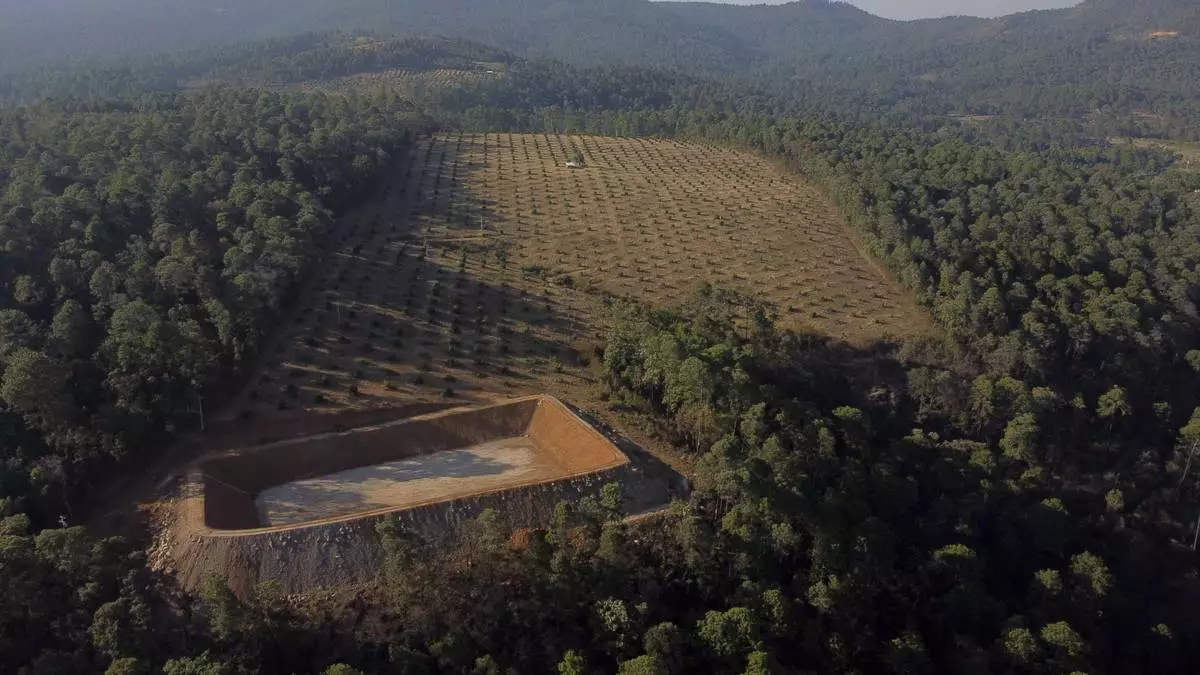
An unlicensed irrigation pond is under construction by an avocado orchard during a drought in the mountains of Villa Madero, Mexico, Wednesday, April 17, 2024. Farmers from Villa Madero who spotted the pond say they plan to meet with authorities to get the pond's owner to agree on a percentage of water usage, and if it fails, they plan to destroy it. (AP Photo/Armando Solis)
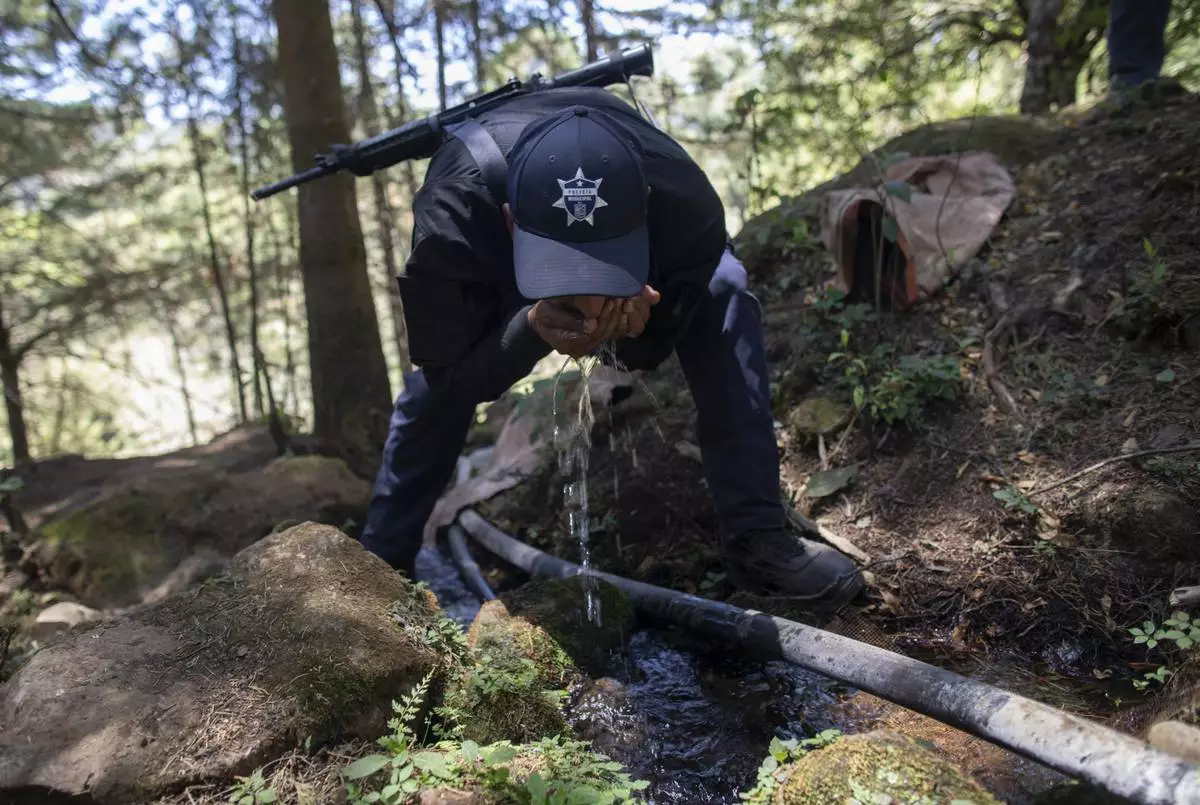
A municipal police officer drinks water from a stream lined with an unlicensed hose as he accompanies locals who are dismantling illegal water taps during a drought in the mountains of Villa Madero, Mexico, Wednesday, April 17, 2024. On Wednesday, dozens of residents, farmworkers and small-scale farmers from Villa Madero hiked up into the hills to tear out irrigation equipment using mountain springs to water avocado orchards carved out of the pine-covered hills. (AP Photo/Armando Solis)
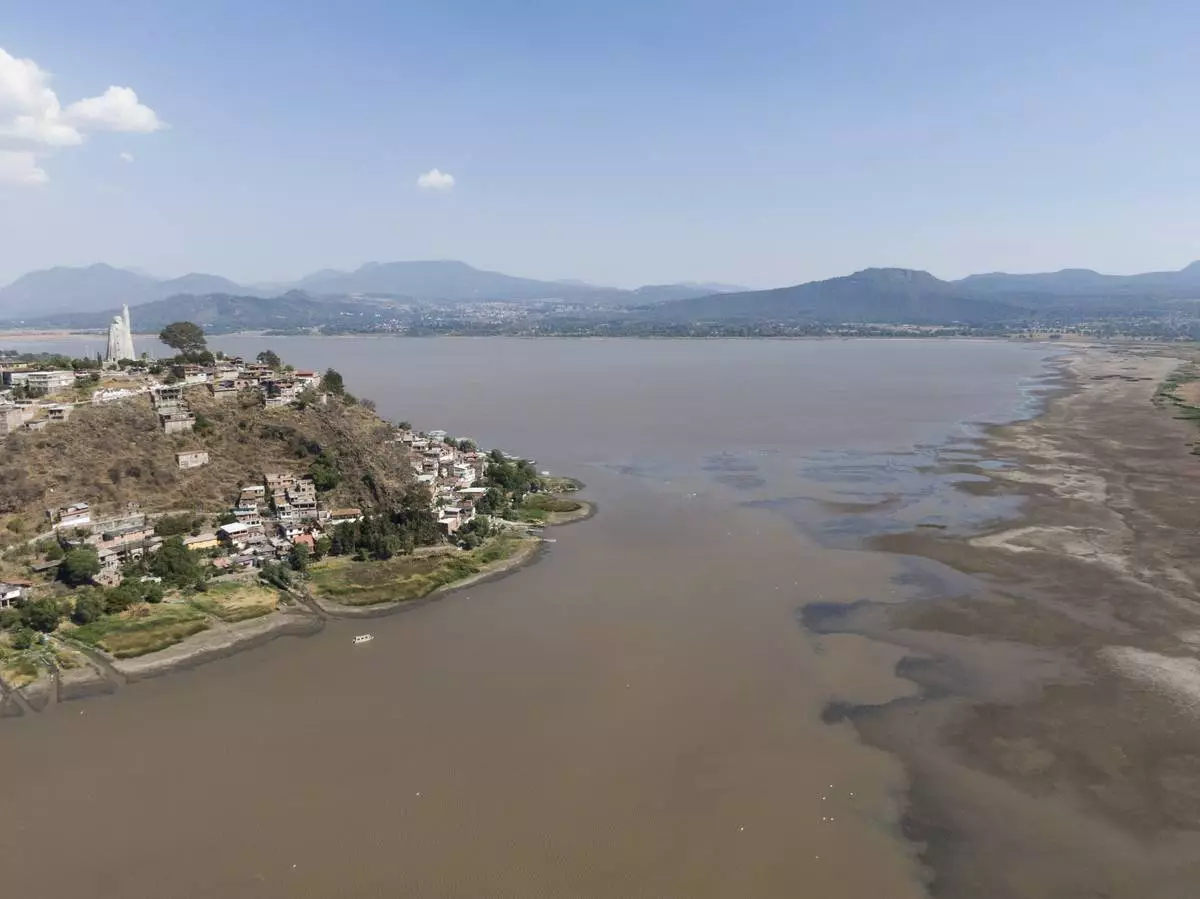
Janitzio Island stands in Lake Patzcuaro, which has low water levels during a drought in Mexico, Thursday, April 18, 2024. Farmers are starting to pasture livestock and plant crops on the lake bed. (AP Photo/Armando Solis)

Residents of Villa Madero look at unlicensed irrigation holding ponds during a drought in the mountains of Villa Madero, Mexico, Wednesday, April 17, 2024. The group said they plan to meet with authorities to get the pond's owner to agree on a percentage of water usage, and if it fails, they plan to destroy it. (AP Photo/Armando Solis)
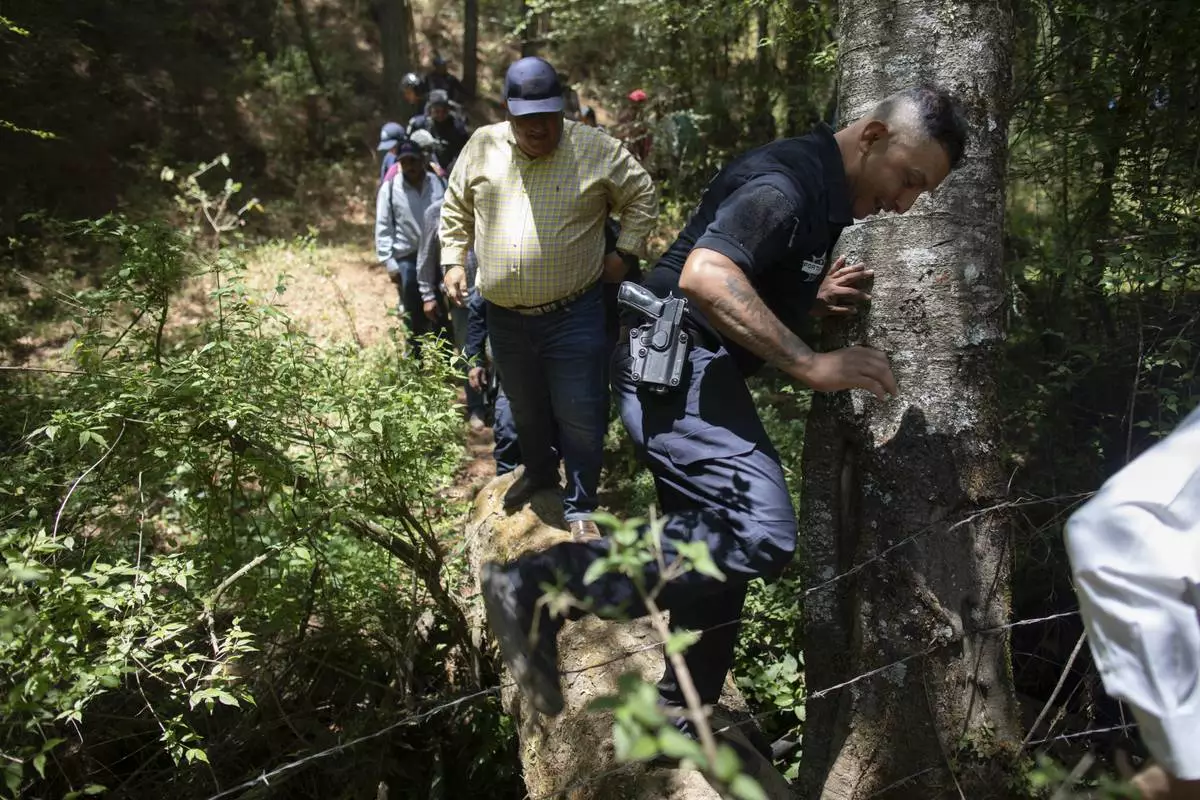
An armed police officer accompanies locals from Villa Madero through the mountains in search of unlicensed water intakes and irrigation ponds during a drought in Villa Madero, Mexico, Wednesday, April 17, 2024. Subsistence farmers and activists from the Michoacan town of Villa Madero organized teams to go into the mountains and rip out illegal water pumps and breach unlicensed irrigation holding ponds. (AP Photo/Armando Solis)
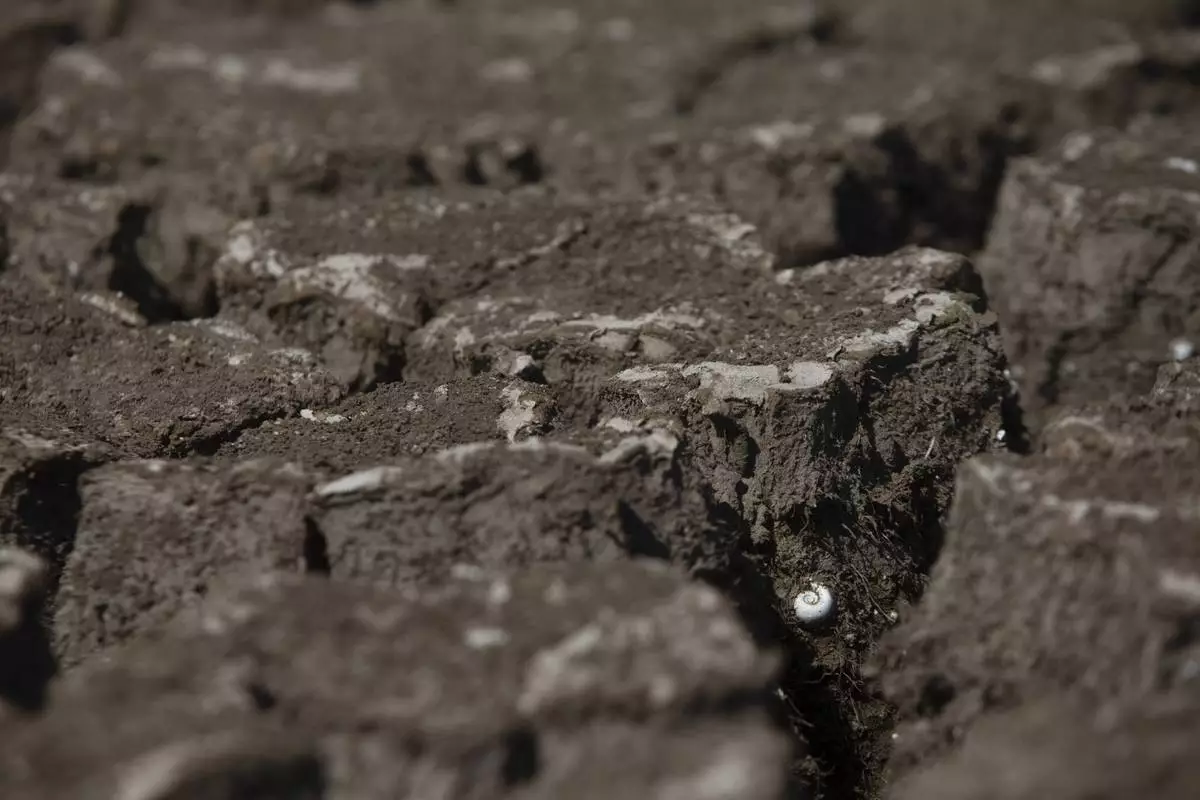
A snail lays in the dry bed of Lake Patzcuaro, during a drought in Mexico, Thursday, April 18, 2024. The lake has been reduced to about half its size, due to drought, deforestation, sediment buildup, and increased water demands from avocado and berry growers. (AP Photo/Armando Solis)

Boats are docked on the shore of Lake Patzcuaro, during a drought in Mexico, Thursday, April 18, 2024. Activist Juan Manuel Valenzuela estimates that 90% of the boats that used to fish and ferry tourists around are now out of service. (AP Photo/Armando Solis)
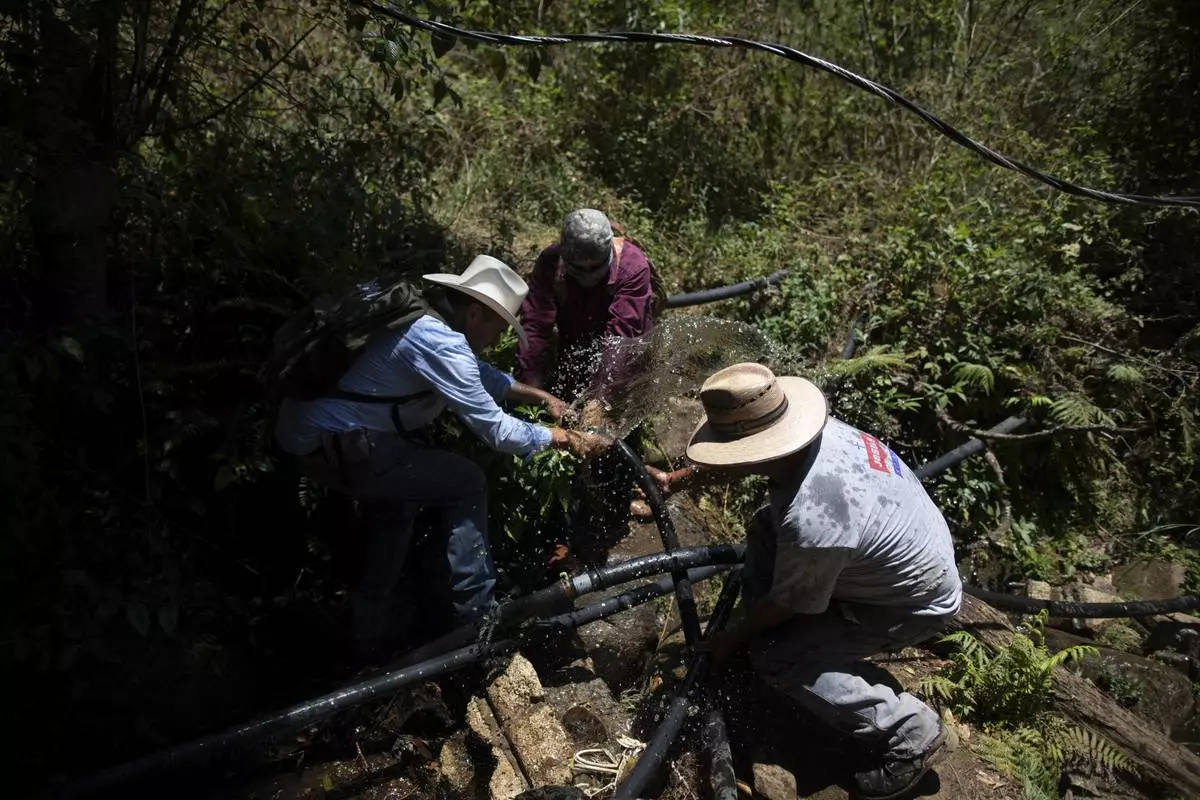
People dismantle an unlicensed water intake as their group of residents, farmworkers and small-scale farmers disconnect water taps in the mountains of Villa Madero, Mexico, Wednesday, April 17, 2024. As Mexico's drought drags on, angry farmers in Villa Madero have begun taking direct action to dismantle illegal water intakes which they say are drying up the streams in the mountains west of Mexico City. (AP Photo/Armando Solis)
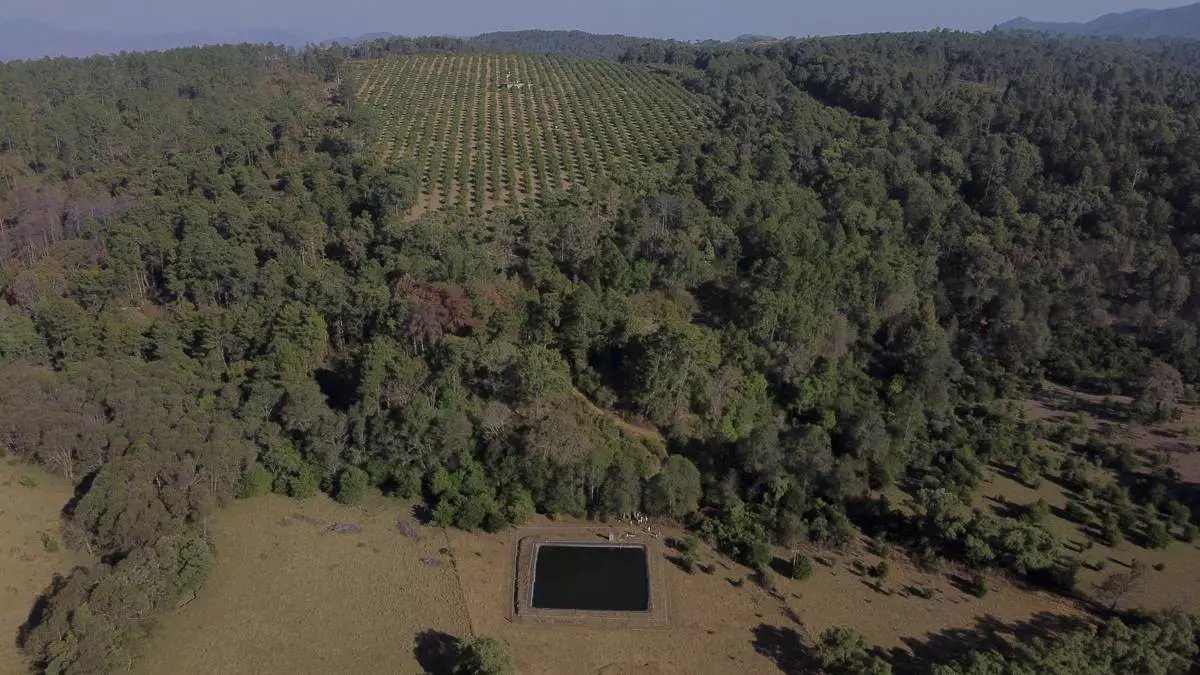
An unlicensed irrigation pond holds water near an avocado orchard in the mountains of Villa Madero during a drought in Mexico, Wednesday, April 17, 2024. Residents from Villa Madero who spotted the pond say they plan to meet with authorities to get the pond's owner to agree on a percentage of water usage, and if it fails, they plan to destroy it. (AP Photo/Armando Solis)
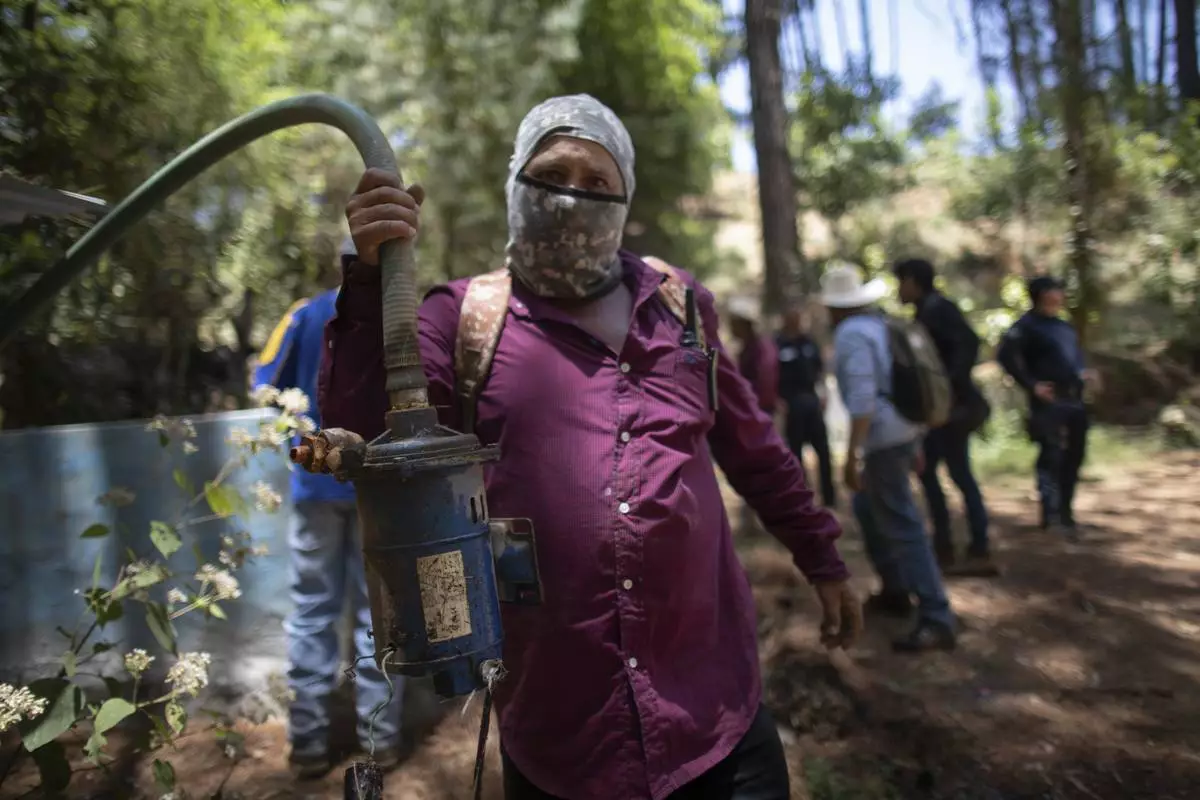
A man shows a pump removed from an unlicensed water intake as his group of residents, farmworkers and small-scale farmers from Villa Madero dismantle illegal water taps in the mountains of Villa Madero, Mexico, Wednesday, April 17, 2024. As a drought in Mexico drags on, angry subsistence farmers have begun taking direct action on thirsty avocado orchards and berry fields of commercial farms that are drying up streams in the mountains west of Mexico City. (AP Photo/Armando Solis)

















